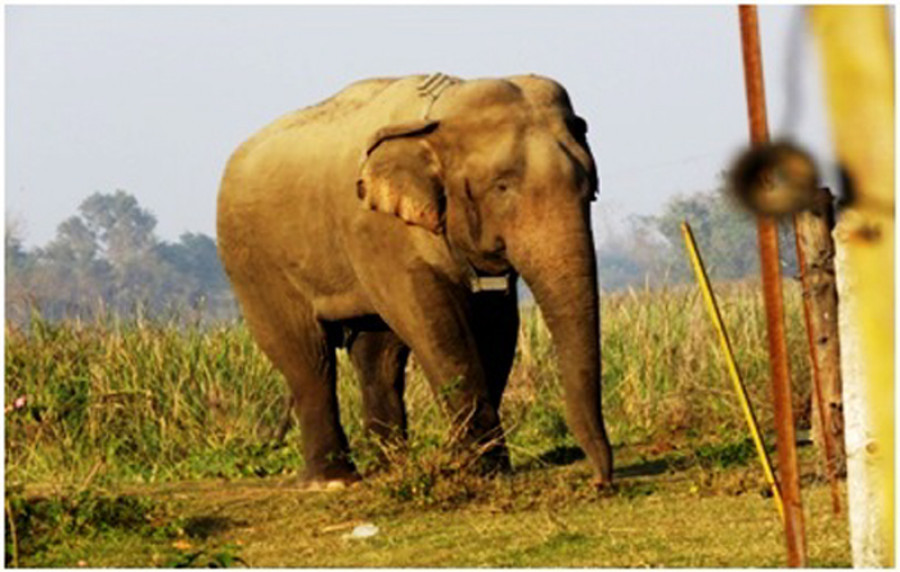Climate & Environment
Koshi Tappu ‘killer’ elephant has calmed down: Officials
There were calls to put down the elephant, an idea that was widely condemned by wildlife conservationists.
Chandan Kumar Mandal
An elephant which the authorities were considering putting it down, for killing people and causing property damage appears to be safe, for now.
The male wild elephant from Koshi Tappu Wildlife Reserve, which recently killed a man in Sunsari, seems to have averted its death as it has not caused any havoc lately.
“The elephant has not caused any damage recently,” said Jhaulai Chaudhary, information officer at the reserve. “The elephant has been sighted in Haripur area, but there haven’t been any reports of damage. It seems the elephant has calmed down.”
On December 14, the elephant killed 28-year-old Pramod Yadav of Koshi Rural Municipality. The incident led to calls from his kin and local residents to execute the animal.
Under growing pressure to take action against the elephant, the Sunsari District Administration had considered killing the pachyderm as one of the options to control its menace.
The issue had met with severe criticism from wildlife conservationists and officials at the centre who pointed out several other measures to tame the elephant.
They also suggested the “makhna” elephant, a lone male tuskless elephant, had gone on a rampage, mostly because it was disturbed by locals during the musth period when elephants go aggressive while looking for mating partners.
Local authorities then called in a team of wildlife technicians from Chitwan to take care of the animal.
“The park was never in favour of killing the elephant,” said Chaudhary. “The team of wildlife technicians darted the elephant twice. Despite demands to kill the elephant, it was never an option for the park authority. We only wanted to tranquilise the animal. It seems to have been pacified.”
Wild elephants from Koshi Tappu Wildlife Reserve, which spans Sunsari, Udayapur and Saptari districts, have long been causing mayhem in surrounding areas.
The death in Sunsari is one of the most recent human-wildlife conflict incidents the country has witnessed in the last few months. Officials say several measures have been adopted to minimise interactions between the locals and wild animals when they come out of the park.
As a measure to control possible interaction between locals and wild elephants, which walk out of the park looking for a mate, park authorities have shifted domesticated elephant stables to the core area of the park.
According to Chaudhary, the domesticated elephants belonging to the park have been shifted across the Koshi, so that wild elephants don’t enter settlements while looking for partners—one of the main reasons behind interactions between locals and elephants.
“The elephants have been shifted deep inside the core area of the park. The new location, which is in Saptari district, is several kilometres away from the park headquarters,” said Chaudhary. “The new stable for elephants is near the Badgama Post where some senior park officials are posted, and there aren’t any human settlements around.”
The measure was one of the many suggested by elephant researchers such as Dinesh Neupane, who have conducted several studies on elephants. According to Neupane, relocating the elephant breeding centre from the park headquarter premises to inside the core area reduces the chances of elephants coming out of the park for mating, subsequently, minimising chances of conflict between humans and elephants.
However, there is a need for long-term solutions, said Neupane, programme director at Resources Himalaya Foundation.
“Installation of an early warning system creates a win-win situation for locals and also for wild elephants. For this, radio-collaring to track the movement of elephants will not be enough and effective,” said Neupane. “People also need to be assigned to oversee the elephant’s movement.”
Neupane suggested forming a network of locals to keep watch over the elephants that can cause menace. “Informants should be appointed for monitoring elephants movement which can also be tracked simultaneously through radio-collaring,” said Neupane. “Such a network of local informants can provide information about the problematic animals in advance hence minimising damages. They can work in a way similar to the local anti-poaching groups.”




 5.14°C Kathmandu
5.14°C Kathmandu










